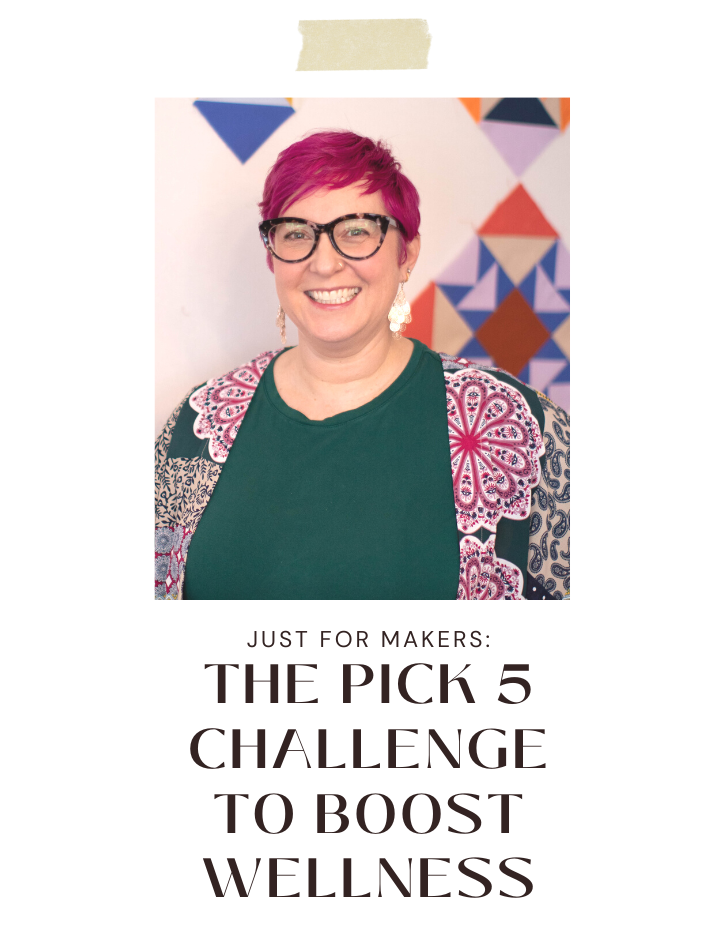It’s only natural that we compare ourselves with others. Checking out the competition is part of our brain’s way of protecting ourselves; we see people and we evaluate them to see if they’re friend or foe.
But what probably served cavemen well is not all that great for us today. We don’t need to assess every single person we see on social media and measure ourselves against them! It’s time for us all to unlearn comparisonitis.
I made a fun project for you about this! It’s called Scraps – a tiny zine for makers, and the first issue is all about comparisonitis. You can download your own copy, print it out and carry it with you to craft shows, quilt guild meetings and more. Scraps is a bonus resource just for my newsletter subscribers, so sign up today!
Defining comparisonitis
Comparisonitis is defined as “the compulsion to compare yourself to others.” The explosion of social media in the last decade has given rise to a wave of comparisonitis across the globe, with people blaming it for a similar increase in mental illness among the heaviest users of social media.
In my coaching practice, comparisonitis is common among my clients. It’s rare when someone shows up for coaching who hasn’t unfairly compared themselves to others.
And can you blame them? Most of my clients are women and nonbinary folks who were raised in a culture that demands we look a certain way, act a certain way, age a certain way. And our pop culture and media are constantly pitting women against each other.
How comparisonitis harms makers
Here are just a few reasons why we need to unlearn comparisonitis:
It causes us to ignore our successes because we’re focused on other folks’ wins
It makes us doubt our creative capabilities and uniqueness
It holds us back from trying new and/or unusual things
It keeps us from taking risks
It leads to withdrawal from creative community
It stops us from getting weird and wonderful
Simply put, “comparison is the thief of joy,” as Theodore Roosevelt summed it up.
In my coaching practice, comparisonitis rears its ugly head in two key ways:
Clients spend lots of energy comparing themselves to others and feel their own work is unoriginal. This is especially true of quilters who sew mostly/only using other people’s patterns. They convince themselves that by doing so, they’re not actually creative, and therefore their art isn’t important or worthy of focus.
Clients spend lots of energy comparing themselves to others and feel their own work will be too unpalatable if they color outside the lines. They focus on staying in the majority, fearing that if they do something too unusual, people will think they’re weird. They fear that they’ll make mistakes if they experiment and don’t want to be seen as someone who screws up.
Can you see how both of these can be true? In fact, some of my clients feel both of these things at the same time. When they’re caught in that self-critical thinking, there’s no way their creative life is going to feel fulfilling.
Identify your triggers and begin to unlearn comparisonitis
If any of this sounds familiar, you’re in the right place. The first step to unlearn comparisonitis is to identify your triggers. Start paying attention to the moments you feel yourself comparing and take a couple notes.
Common triggers include things like:
Craft shows where your friend is exhibiting beautiful wares (and you feel like you don’t measure up)
Craft group meetings where folks are showing their work
Juried art shows where people win awards
Show and tell at quilt guild meetings
Magazines and newsletters about your art/craft
Social media

Instagram recently began offering the opportunity to turn off “like” counts on images and videos, and doing so can really help reduce comparisonitis
Social media is often the culprit
Time and again, the main cause of comparisonitis is social media. If you find yourself scrolling and scrolling and feeling sadder and sadder, stop! Try following these steps:
Limit your social media time using your phone’s settings
Delete your social media apps and take a break from them altogether, or only use them on your laptop/desktop computer
Unfollow any person who triggers you to compare – even if you feel like you’re “supposed” to follow them and know what they’re up to (for example, there are a few modern quilters all my friends gush about all the time but they make me feel less-than, so I remain clueless and that’s fine!)
Follow people who inspire you and make you want to be more creative
Use Instagram’s Following and Favorites controls, currently found in the upper left-hand corner of the app’s home screen – so you only look at the people you truly want to see
Turn off Instagram’s suggested posts in your feed (you’ll need to refresh this monthly)
Practice gratitude to unlearn comparisonitis
Once you’ve limited some of your triggers, fill that time with a little gratitude. This practice requires mindfulness, and only a few minutes a day.
Gratitude helps you stay in touch with reality, while scrolling endlessly through social media keeps you untethered. Let’s get grounded in reality! Try these steps:
Keep a daily journal for your gratitude practice (could be as simple as the Notes app on your phone)
Set a timer each day and write for five minutes
Note all the ways you’re thankful for creativity in your life
List the people, things and experiences for which you’re grateful
Include gratitude for yourself for your commitment to unlearn comparisonitis!
Refer to your journal whenever you feel the desire to compare
Share your process with a friend who could also benefit from unlearning comparisonitis
Consider how you would talk to…
Here’s another exercise to try. Consider how you would speak to your BFF. Imagine your bestie is comparing their work negatively with that of others. How would you encourage them to gain a kinder perspective toward themselves? What would you say? Write down the exact words you would use. Now say that to yourself – how does it feel?
Now here’s the twist on this that always works for me. Imagine your own child or nibling (niece or nephew) is being self-critical or hating their own creative work. How would you comfort them? What advice would you share? Again, write out exactly what you would say. Really imagine that scenario and the deep emotion it raises. Then imagine YOU are that kiddo. Because you are – that childlike spirit is in you! How would the little-kid version of you feel to hear encouragement? Take it in.

Practice mudita
Mudita is a Buddhist term meaning joy, especially sympathetic or vicarious joy from the well-being of others.
You don’t have to be a Buddhist like me to practice mudita. Anyone can embody mudita! When you find yourself comparing and feeling envious, take a breath. Try to feel happy for the other person – I mean, really happy. Try to imagine what their joy feels like, and breathe that into your body.
With this practice, you might have to fake it til you make it. It can be hard to force yourself to feel joy when you’re also feeling jealousy. But practice and with time, it gets easier.
If you must compare, compare to yourself
Finally, if none of these other practices are working and you still feel the need to compare, try comparing yourself to yourself:
Recall what it felt like when you first began your art or craft
Find some of your earliest creations and remember how hard you worked on them
Ask yourself: “How far have I come? What have I overcome to get here?”
Explore how different you feel today compared to your early days
Ask: “What do I know now that I didn’t know back then?”
Consider what lessons you’ve learned that you could teach others today
Rejoice in how far you’ve come!
What’s your next step?
Now that you’re armed with a handful of techniques to unlearn comparisonitis, what’s your next step? Jump in the comments below and fill me in – I’d love to hear about your process. Not to compare to my own… but to perhaps enjoy a little mudita regarding your work to feel more self-confident!


